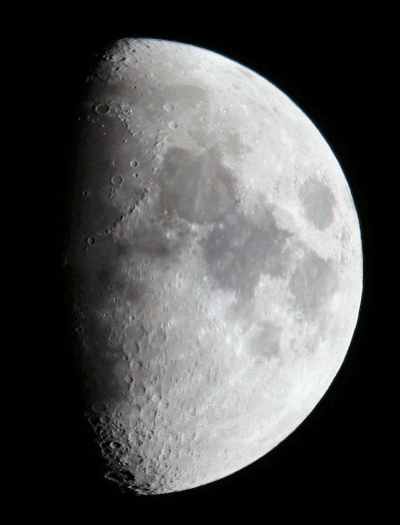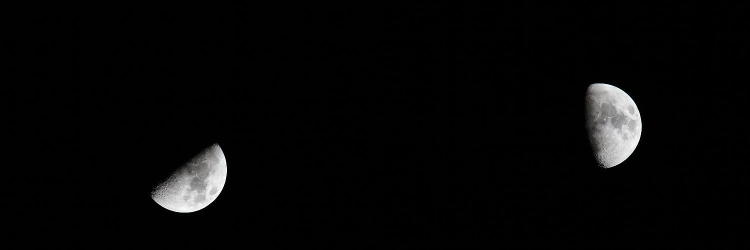It’s been a long time coming, but I finally got my timing down. Again, I mean.

I’ve talked about this countless times now, but for those who have not seen any of the earlier posts, I’ve had a goal of catching sunrise on the central peak of the Tycho crater on the moon for a while now, and earlier this evening, just a little after sundown actually, I snagged it. Tycho is the prominently deep, but not too large, crater down near the bottom, the one with the little dot in the middle which is its 1.6-kilometer-tall central peak; it’ll catch the rising sun before the crater floor does, of course, and that spot of light against the shadow is what I was after.
Now granted, this is a little anti-climatic, given that I’ve captured it before without really trying, and didn’t even know it for years, but this is the first with a conventional camera and lens (the Tamron 150-600, of course.) And you can check out plenty of other posts under that first link above to see just how often I’ve tried, if you’re bored. But I was slightly prepared for this one, because I shot the moon last night and knew how far along the sunrise (or phase, from our perspective) was then.

Tycho is not even beginning to be illuminated here, but I know from mapping that it’s not far out of sight in the shadow. The notable crater with the central peak in this image, about a third of the way up from the bottom, is Arzachel. Don’t get the impression that I recite these from memory; I know a handful of craters by rough position, and everything else I determine from fantastic maps like this one. Full credit to the illustrators: each feature is shadowed as if by late lunar morning, so the craters and mountains can easily be discerned, which is hundreds of times better than, say, Google Earth’s version which shows all features at lunar noon from their perspective. This renders craters into indistinct circles, like those seen over at the right side on my images here. The shadows provide the shape and height and such, which is why (again) I say that full moons are far less interesting than any other time (well, except for new moons – they’re really boring, except at certain times.)
Even with the map, however, plotting moon features can be challenging, because perhaps a large portion of the moon is in shadow, reducing the number of ‘landmarks’ you can use, while the shadows or lack thereof can cause things to look very different from your guide source. I usually switch back and forth a bit between my images and a guide, comparing various visible features like lines of mountains and craters within craters and such.
 But then I had to do this, and it came out fairly well despite the difficulties. This is just the two images above overlaid, with faded transitions between the two, showing how much the lunar day has advanced in one full Earth day: not much. It’s not quite accurate, because the difference is 20.5 hours instead of 24, and for accuracy I should be out shooting the moon right at this moment but I’m not gonna. That’s the kinda sloppy journalism and illustrations that you’ve come to expect from me, and I see no reason to change now. And yes, it doesn’t look ‘perfect,’ because the two moons were actually oriented differently in the viewfinder because of this difference in shooting times, and I had to resize and reposition the two images to match, which is a hell of a lot harder than it sounds, PLUS, the moon wobbles a little (libration,) and there is no way to do a perfect match anyway – part of what you’re seeing are my errors, and part is simply this natural wobbling motion. You can also see a faint difference in exposure, especially if you look to the top right, and this is because the moon gets brighter as the phases advance, due to more sunlight reflecting directly rather than obliquely, and exposure times have to be adjusted to compensate. Again, I could have tweaked it in GIMP for a close match but didn’t bother. What you should be looking at is the changes in definition near the terminator; not just Tycho appearing, but other features becoming less distinct as the sun rises higher for them, shortening the shadows.
But then I had to do this, and it came out fairly well despite the difficulties. This is just the two images above overlaid, with faded transitions between the two, showing how much the lunar day has advanced in one full Earth day: not much. It’s not quite accurate, because the difference is 20.5 hours instead of 24, and for accuracy I should be out shooting the moon right at this moment but I’m not gonna. That’s the kinda sloppy journalism and illustrations that you’ve come to expect from me, and I see no reason to change now. And yes, it doesn’t look ‘perfect,’ because the two moons were actually oriented differently in the viewfinder because of this difference in shooting times, and I had to resize and reposition the two images to match, which is a hell of a lot harder than it sounds, PLUS, the moon wobbles a little (libration,) and there is no way to do a perfect match anyway – part of what you’re seeing are my errors, and part is simply this natural wobbling motion. You can also see a faint difference in exposure, especially if you look to the top right, and this is because the moon gets brighter as the phases advance, due to more sunlight reflecting directly rather than obliquely, and exposure times have to be adjusted to compensate. Again, I could have tweaked it in GIMP for a close match but didn’t bother. What you should be looking at is the changes in definition near the terminator; not just Tycho appearing, but other features becoming less distinct as the sun rises higher for them, shortening the shadows.
Yes, others have done entire lunar days in this manner, which takes a full month of photographs, some of which have to be done during Earth daylight or, you know, shot from above the atmosphere – I probably won’t tackle that aspect anytime soon, even though I am bereft of lunar projects now. But there are plenty of other craters and details I could be aiming for. For now, a quick comparison between the two images used here, this time full-frame as shot, so you can see the difference in angle that I had to correct for in the gif (pronounced “shuh-VON,”) and have a better inkling of what it looked like in the viewfinder as I was trying to nail sharpest focus.

Annnndddd one more little trivial bit. Last night when I was shooting the moon partially as a test, I tried out something else that’s been on my photographic plate – I mean, a figurative photographic plate – and got the answer that I needed. Not at all the one I’d hoped to get, but at least it’s a baseline data point.

The fuzzy blob you see here is the Andromeda galaxy, or M31 in Messier’s catalog, NGC224 in the New General Catalog. Andromeda can be found on a clear night with binoculars, if you know exactly where to look, and on rare occasions by unaided eye, but it takes optimal conditions and even then you may only see it peripherally, since peripheral vision tends to resolve fainter objects than our direct (foveal) vision. The faint lines all around are stars, moving slightly in the 3.2 second exposure and also faintly out of focus, because if you think the moon is hard to pin down precisely, try it on dim stars. I’d love to get a more detailed shot of Andromeda, but this image tells me that it will come only with the help of a tracking motor, to counteract the rotation of the Earth during a much longer exposure, and more likely also a good telescope. You’re not gonna see it before the year is out, is what I’m saying.
I was trying out this camera body at its highest ISO rating to see what it produced, which is why the image is so grainy, but actually, it’s better than expected in that regard – less so in the resolving-the-object one. But c’mon, Andromeda is 2.5 million light-years off! And so you know, this image was shot at 3.2 seconds, f6.3, ISO 6400, while the moons up there were shot at 1/50 or 1/60 second, f11, ISO 250. What this means in photographic terms is that this image of Andromeda captured just shy of thirteen thousand times more light than the moon shots. And it still looks like this. Bugger.
















